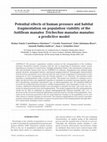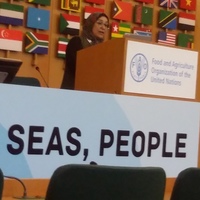Papers by Nataly Castelblanco Martínez

Endangered Species Research, 2012
We present a population viability analysis for the metapopulation of the Antillean manatee Triche... more We present a population viability analysis for the metapopulation of the Antillean manatee Trichechus manatus manatus with the aim of predicting its tendencies under various hypothetical scenarios of conservation. Multiple individual Monte Carlo simulations of deterministic and stochastic factors were run on VORTEX 9.73 software. Populations were defined using genetic structure, geographic barriers, and typical ranging behavior. Demographic characteristics and life history parameters were inferred from the most recent compilation of information on the subspecies or were extrapolated from the Florida manatee T. m. latirostris. The baseline model describes a metapopulation with a positive growth. This model was sensitive to changes in mortality, but did not show any significant response to variations in assumed carrying capacity, age at first reproduction, maximum reproductive age, or initial population size. We simulated different scenarios by modifying human pressure, habitat fragmentation, and catastrophic events (i.e. hurricanes). Additional combined models were developed to simulate the best-and worst-case scenarios for human pressure level and fragmentation. The model suggested that the metapopulation would not be able to withstand an annual anthropogenically induced mortality rate > 5%. A decrease in the survival of transient individuals could also lead to a decline of the population. Variations of the hurricane parameters did not yield important changes in the population curves, but other effects of climatic change are discussed. The extensive geographical area used by manatees requires international collaboration to ensure the protection of the metapopulation through effective conservation strategies across countries.
West Indian manatees (Trichechus manatus) are separated into two allopatric subspecies: the Flori... more West Indian manatees (Trichechus manatus) are separated into two allopatric subspecies: the Florida manatee (T. m. latirostris) and the Antillean manatee (T. m. manatus). In the winter of 2020-2021, an adult manatee was sighted off the coast of Cancun, Quintana Roo, Mexico, in areas where Antillean manatees are not typically seen. The individual had distinct watercraft scars on its body, which were matched using photo-identification to a known male Florida manatee (PE424) that had been repeatedly photographed in Florida since 1998. The data presented are the verified photo-documented sightings history of PE424 from Florida and Mexico.
Mammalogy Notes
Invasive alien species (IAS) are considered the second greatest threat to biodiversity after habi... more Invasive alien species (IAS) are considered the second greatest threat to biodiversity after habitat loss; and therefore, they need to be controlled promptly to avoid irreversible damages to the ecosystems and loss of species. However, this is not an easy task when the IAS is also a charismatic animal. Here, I analyze the case of the invasive hippos in the Magdalena River basin (Colombia) as an example of an IAS charisma. The charisma of this mega-mammal may have affected the Colombian people’s perceptions and attitudes toward its management, and ultimately delayed or prevented control implementation. A transdisciplinary approach considering both biological and non-biological aspects of hippo’s management in Colombia is critical in solving this environmental dilemma.

CBM - Cahiers de Biologie Marine, 2020
Baseline data on the distribution and occurrence of marine mammals are needed to better understan... more Baseline data on the distribution and occurrence of marine mammals are needed to better understand their role in marine ecosystems and to protect them from the negative impacts of climate change and human activity. Here, we report the results of vessel-based surveys to document marine mammals throughout the territorial waters of Belize in the Western Caribbean Sea. In 2016 and 2017, 543 km of transects (85 h of survey effort) aboard a 14-m catamaran resulted in 17 sightings of four species of marine mammal: inshore and offshore bottlenose dolphins Tursiops truncatus, Atlantic spotted dolphins Stenella frontalis, pantropical spotted dolphins Stenella attenuata, and Antillean manatees Trichechus manatus manatus. Coastal manatees and bottlenose dolphins were found in shallow waters and all other species exclusively in deep waters east of the Mesoamerican Barrier Reef System. These preliminary findings suggest there is a low density of marine mammals in the offshore habitats of Belize. ...

Revista de Investigaciones Marinas, 2014
El manatí (Trichechus manatus) depende de vegetación acuática como fuente de alimento. El present... more El manatí (Trichechus manatus) depende de vegetación acuática como fuente de alimento. El presente trabajo tiene como objetivos comparar la aparición de los componentes más importantes de la dieta de tres individuos entre diferentes porciones de su tracto digestivo. Además, elaborar una colección de fotografías de referencia de los fragmentos de las fanerógamas marinas y otros elementos que pueden ser comúnmente observados en la dieta de individuos de esta especie, para su identificación en estudios de material digestivo. Para ello se realizó un análisis microhistológico del contenido digestivo (estómago, intestino y heces) de animales procedentes del sur de Varadero (Matanzas) y costa norte de Villa Clara. Todos los componentes encontrados fueron característicos de ecosistemas marinos, lo que indica el uso de este tipo de hábitat como sitio de alimentación por estos individuos. Se encontró alta abundancia de rizomas en las muestras fecales de manatí, lo que sugiere la remoción de l...










Uploads
Papers by Nataly Castelblanco Martínez